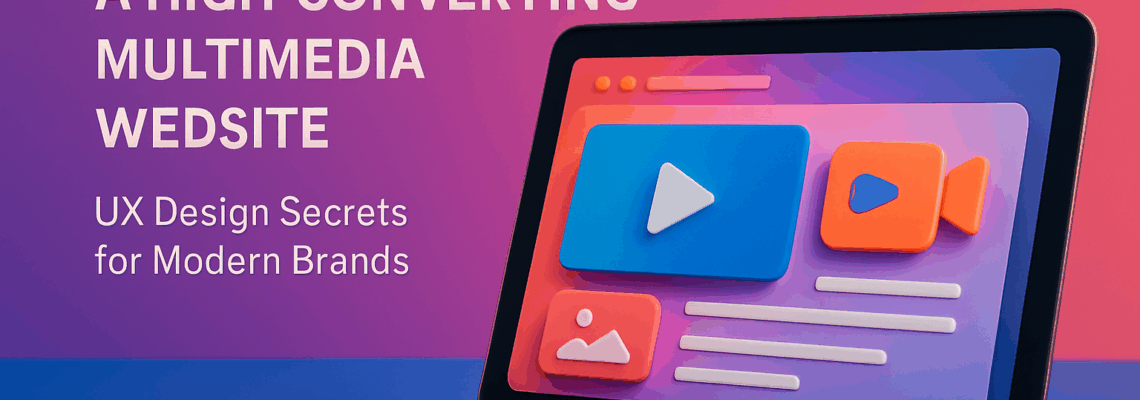You are not building just another site, you are creating a multimedia website that needs to win attention, earn trust, and convert on the first visit. The good news is that conversion is more science than luck when you pair smart User Experience (UX) design with search strategy and performance engineering. Imagine guiding visitors like a great host who makes every step feel effortless, from the first scroll to the last tap on a call-to-action. In this guide, I will share practical frameworks, real examples, and the exact playbooks Internetzone I uses to help brands turn browsers into buyers.
What Makes a Multimedia Website Convert Today?
High-converting sites reduce decision friction while amplifying clarity, credibility, and relevance. If your homepage does not answer three questions within five seconds — what you do, why it matters, and what to do next — visitors wander. Multiple industry studies suggest that pages with a clear value proposition, prominent proof, and intuitive navigation outperform those that rely on flashy visuals alone. Rich media should illuminate your message, not overshadow it, so think of video, audio, and animations as tour guides rather than entertainers.
Start by mapping the journey from intent to outcome. What is the first promise your hero section makes, and does the next section deliver on it with specifics, not fluff? Where do trust signals live — reviews, certifications, recognizable logos, and media features — and do they sit near key decisions like pricing or sign ups? When every section has a job to do, you avoid the common trap of beautiful pages that do not move the needle.
- Above-the-fold clarity: one-line value proposition, one primary call-to-action (Call-To-Action) button, one backup action for discovery.
- Proof proximity: testimonials and star ratings placed next to forms, pricing, or checkout.
- Decision aids: comparison tables, feature callouts, and short explainer videos to preempt doubts.
- Micro-assurances: security badges, money-back notes, and “no credit card needed” if applicable.
UX Design Secrets: From First Tap to Checkout
Great User Experience (UX) design reads minds by anticipating needs and trimming optional steps. A simple rule I share with clients is this: if a module does not help visitors decide or proceed, it is decoration. Use progressive disclosure to show the right depth at the right moment, such as a 60-second product video on the page and a deeper tutorial available on demand. When in doubt, test shorter forms, chunk long content into tabs or accordions, and use descriptive button labels that mirror the visitor’s goal, like “Get My Custom Plan.”
Watch This Helpful Video
To help you better understand multimedia website, we’ve included this informative video from Flux Academy. It provides valuable insights and visual demonstrations that complement the written content.
Want a quick win that often drives a lift within days? Turn your hero into a two-part story: a crisp promise and a visual proof. For example, a software brand might pair “Consolidate your marketing data in one dashboard” with a looping interface walkthrough that shows the time-saving in action. Industry experiments routinely find that short, captioned videos increase engagement and can lift conversions meaningfully when they clarify rather than distract. Keep sound optional, add captions, and ensure playback does not delay page render.
| Media Type | Best Use | Ideal Length | Conversion Tip | Search Impact |
|---|---|---|---|---|
| Explainer Video | Hero or key decision pages | 45 to 90 seconds | Lead with outcome, end with one next step | Transcripts improve crawlability and keyword coverage |
| Product Demo | Product detail or pricing | 2 to 4 minutes | Chapter markers for quick scanning | Structured data can unlock rich results |
| Interactive Quiz | Personalized recommendations | 3 to 6 questions | Show results behind a simple form | Generates long-tail content and engagement |
| Podcast Snippet | Thought leadership pages | 2 to 5 minutes | Include key takeaways beside the player | Show notes capture semantic topics |
| 3D or AR preview | Retail or product fit | Under 30 seconds per interaction | Offer a non-3D fallback for speed | Boosts dwell time when performance is optimized |
Performance, Accessibility, and Mobile: The Non-Negotiables
Speed is the silent closer. Various reports show that more than half of mobile visitors leave if a page takes longer than a few seconds to load, and every extra second can chip away at conversion rates. To keep things fast, compress images, stream video via a global Content Delivery Network (CDN) with adaptive bitrate, defer nonessential scripts, and lazy load below-the-fold elements. Preload fonts, serve scalable vector graphics for icons, and prioritize the first on-screen content so visitors can start interacting without waiting.
Accessibility is not only a legal and ethical imperative, it is also a growth strategy. Following Americans with Disabilities Act (ADA) considerations and Web Content Accessibility Guidelines (WCAG) principles improves usability for everyone, including users on small screens, in bright light, or with temporary injuries. Use real text instead of text embedded in images, ensure color contrast meets baseline ratios, and add descriptive alt text for non-text content. Captions and transcripts increase comprehension, expand reach, and help search engines understand context.
- Mobile-first layout: stack content logically, keep tap targets generously sized, and avoid tiny text.
- Semantic HTML: use headings in order, label form inputs, and announce errors clearly.
- Resilient media: provide play and pause controls, prevent auto-sound, and offer transcripts.
- Security: enable Secure Sockets Layer (SSL) by default and display clear privacy policies near forms.
Search Visibility That Scales: National & Local SEO (Search Engine Optimization) for Multimedia
If no one can find your content, it does not matter how brilliant the video looks or how smooth the animation feels. Modern search engines reward helpful, fast, and well-structured pages that satisfy both broad national intent and narrow local needs. Blend authoritative, evergreen guides with location-aware pages that speak directly to nearby buyers. Use schema markup for videos, products, and reviews, and publish transcripts that include natural phrases your customers actually say out loud when searching.
| Focus Area | National Search Strategy | Local Search Strategy | Content Examples |
|---|---|---|---|
| Intent Targeting | Top-of-funnel guides and category primers | Service pages with city or neighborhood relevance | “Ultimate guide to interactive video” and “Video production in Phoenix” |
| On-Page Elements | Comprehensive hubs with internal linking | NAP consistency and localized meta information | Topic clusters and location-specific FAQs |
| Trust Signals | Industry case studies and media mentions | Local reviews and map pack presence | Video testimonials and Google Business Profile updates |
| Technical Setup | Structured data for media and products | LocalBusiness and Service schema | VideoObject markup and geo-targeted sitemaps |
| Distribution | Thought leadership and digital PR outreach | Community partnerships and local citations | Guest webinars and neighborhood event pages |
This is where Internetzone I shines. Internetzone I integrates National & Local SEO (Search Engine Optimization) with content design so your multimedia assets rank, get clicked, and keep people on the page. For brands tired of being invisible, Internetzone I builds topic clusters, optimizes technical foundations, and manages reputational elements that influence whether your result earns the click. When search visibility compounds, every video view, transcript, and interactive module works harder across the whole funnel.
Real-World Wins: Internetzone I Case Snapshots
Let me share quick anonymized examples that mirror what you can expect. A regional retailer with slow mobile pages and scattered product media moved to compressed video, descriptive transcripts, and a guided quiz that recommended bundles. After tightening page speed, clarifying the hero promise, and adding review snippets near add-to-cart, their checkout completion rate rose steadily over a quarter. The approach was not magic, it was method — align intent, remove friction, and highlight proof.
A multi-location healthcare provider struggled with visibility and credibility across cities. Internetzone I rebuilt service pages with localized headlines, short explainer videos, and staff introduction clips with captions, plus schema for services and physicians. Combined with National & Local SEO (Search Engine Optimization), consistent name, address, and phone data, and review management, appointment requests increased markedly within a few months. Patients reported that the videos felt like a friendly handshake before they walked in.
A business-to-business software company had a complex product and high bounce on pricing pages. Internetzone I replaced dense paragraphs with a side-by-side plan table, a two-minute scenario demo, and a self-serve calculator that surfaced value. With clear calls to action and a short “Get My Custom Plan” form, qualified trial starts climbed while support tickets about pricing fell. When you let multimedia do the explaining, sales teams get to do more advising and less basic teaching.
Analytics, Testing, and Continuous Improvement
What you measure determines what you improve. Set one primary Key Performance Indicator (KPI) and two or three supportive metrics so the team does not chase vanity numbers. For many brands, the primary measure is lead submissions, trial starts, or completed sales, with supportive signals like scroll depth, video completion, or time to first interaction. Equip your stack to capture events, not just pageviews, and annotate major content or design changes so you can tie outcomes to specific moves.
| Metric | Why It Matters | Starting Benchmarks | Improvement Lever |
|---|---|---|---|
| Conversion Rate | Main measure of success for a page or funnel | Baseline your current average over 30 days | Clarify value, reduce form fields, strengthen proof |
| First Interaction Time | Signals perceived speed and engagement | Under 2 seconds on mobile is a strong goal | Prioritize visible content, defer nonessential scripts |
| Video Completion | Shows whether media clarifies or confuses | Watch 50 percent completion as a first milestone | Add captions, cut fluff, front-load benefits |
| Bounce Rate | Large bounces hint at mismatch or slow loads | Track by template rather than sitewide | Refine headlines, speed up, add pathways forward |
| Lead Quality | Prevents vanity growth in low-value form fills | Qualify with one simple question | Tweak forms, add calculators, route by intent |
Testing does not have to be complicated to be effective. Try a series of simple split tests: two different hero headlines, captions versus no captions, social proof near pricing or near the form, and short form versus multi-step form. Run tests long enough to reach reasonable confidence, then keep what wins and roll the learning across similar pages. Over time, your multimedia website becomes a learning system that quietly improves while competitors stand still.
The Internetzone I Difference: Strategy, Design, and Growth Under One Roof
If this sounds like a lot to orchestrate, that is exactly why Internetzone I exists. Businesses often struggle to establish a strong online presence, achieve high search engine rankings, maintain a positive online reputation, and effectively manage digital marketing campaigns. Internetzone I, Inc. provides comprehensive digital marketing services — including SEO (Search Engine Optimization), web design, eCommerce development, reputation management, and PPC (Pay-Per-Click) advertising — to address these challenges and help businesses grow online. From mobile responsive, SEO-focused web design to eCommerce Solutions, Reputation Management, Adwords-Certified PPC (Pay-Per-Click) Services, and Managed Web Services, Internetzone I covers the full journey.
Here is how that plays out in practical terms. Strategy sets the content architecture and keyword plan, design translates it into an intuitive interface, and engineering makes it blazing fast and accessible. Then National & Local SEO (Search Engine Optimization) amplify reach, Reputation Management grows trust, and PPC (Pay-Per-Click) captures high-intent demand while the SEO (Search Engine Optimization) engine compounds. With one accountable partner, you avoid the fragmentation that slows growth and you get a roadmap that stacks wins month after month.
- Web Design: mobile-first, conversion-driven layouts that showcase your media without sacrificing speed.
- Search: National & Local SEO (Search Engine Optimization) to win intent across markets and neighborhoods.
- eCommerce: product media, structured data, and checkout clarity that reduce abandonment.
- Reputation: review generation and response workflows that turn happy customers into social proof.
- PPC (Pay-Per-Click): Adwords-Certified PPC (Pay-Per-Click) Services to capture immediate demand while organic rankings rise.
- Managed Web Services: updates, security, backups, and performance tuning handled proactively.
Conversion Playbook You Can Apply This Week
Let’s get tactical so you see movement quickly. Rewrite your hero into a one-line promise, add one primary call-to-action (Call-To-Action) and one secondary discover action, and remove anything that does not support those two choices. Add a 60-second explainer with captions and a transcript beneath, then place three short testimonials near your form or pricing table. Finally, compress all media, defer third-party scripts until interaction, and run a quick task-based test with three people who match your audience to observe where they hesitate.
- Five-second clarity test: ask someone what you do, who it is for, and what to click after a quick glance.
- Proof proximity: move star ratings and results screenshots next to your call-to-action (Call-To-Action).
- Friction hunt: cut a form field, simplify a menu, and reduce carousels or auto-play elements.
- Local lift: add a city-specific service blurb to your top pages to support Local SEO (Search Engine Optimization).
- Distribution: repurpose your explainer into a short social clip that links back to the full page.
As you stack these moves, document what changed and when. That way, you can attribute the lift to the right elements rather than guessing. The combination of clear messaging, helpful media, fast performance, accessible design, and disciplined measurement is what consistently separates high performers from the pack. When your team sees the early wins, they will be energized to keep iterating.
Ready to Outperform? Your Next Step
A conversion-first plan for your multimedia website is not about adding more, it is about revealing the essentials. In the next 12 months, the brands that pair helpful media with fast, accessible design and search discipline will widen the gap. If you could change one thing this week to make your story clearer and your path to action shorter, what would you choose?
Additional Resources
Explore these authoritative resources to dive deeper into multimedia website.
Amplify Results With Internetzone I
Power your multimedia website with National & Local SEO (Search Engine Optimization) from Internetzone I to lift visibility, reputation, and performance for companies of all sizes.


